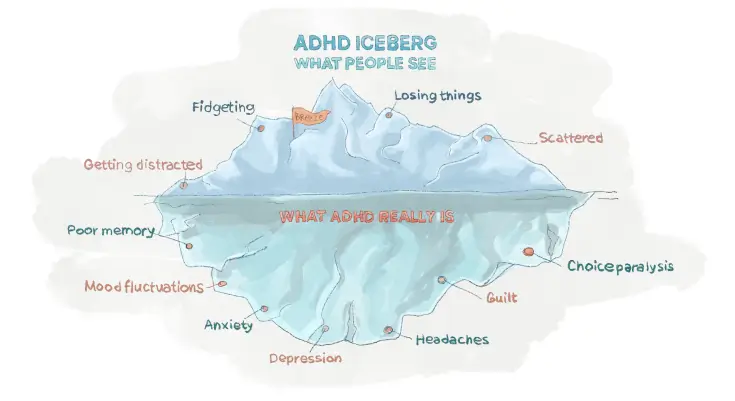When you hear about ADHD, what is the first thing that comes to your mind? Trouble concentrating? Or maybe someone who is bouncing off the walls?
It could be, but those ideas only scratch the surface of what ADHD is really about. It’s way more complex than that. Scattered thoughts, forgotten deadlines, and surprising creativity are only part of the story. There is much more to explore.
To better understand the visible and hidden sides of ADHD, the ADHD iceberg metaphor was created.
This article explores the hidden depths of ADHD and how the ADHD iceberg can change your understanding of this condition in a whole new light.
What is the ADHD iceberg?
Have you ever seen that ADHD iceberg graphic? It’s surprisingly accurate! The ADHD iceberg was originally created in 1998 by school psychologist and long-time ADHD advocate and trainer Chris A. Ziegler Dendy.
So, imagine an iceberg. You’ve got that little bit sticking out of the water—that’s what most people think of when they think of ADHD: fidgeting, easily distracted, and super talkative. Those are the obvious bits.
But, like a real iceberg, the most significant parts of ADHD are hidden way down deep. That’s where you’ll find mood fluctuations, the constant fear of rejection, the fact that planning a trip to the grocery store can feel like quantum physics, and all those less obvious challenges.

These less visible and internal symptoms are just as much a part of ADHD that no one talks about. They’re more complex to spot and often misunderstood.
For example, let’s say your coworker with ADHD gets upset over a seemingly minor suggestion you make. You might think they’ve overreacted, but it could be something called Rejection Sensitive Dysphoria (RSD).
People with RSD feel intense emotional pain in response to real or perceived rejection, and it is often (though not always) present in those with ADHD.
Now, to get the whole picture of the ADHD iceberg in adults, let’s briefly discuss some of its more visible signs.
Visible symptoms of the ADHD iceberg
External symptoms of ADHD can be divided into three categories: inattention, hyperactivity, and impulsivity. These categories correspond to the three main presentations of ADHD: Inattentive, Impulsive/Hyperactive, and Combined.
Inattention
- Difficulty focusing: People with ADHD get sidetracked easily – one minute, they’re working on a project, and the next, they’re checking their phone.
- Difficulty completing tasks: For someone with ADHD, it might be particularly challenging to stay committed to tasks that are routine, repetitive, or of no personal interest to them.
- Hard to stay organized: Space might be a bit chaotic, leading to frequent loss of belongings like keys or important papers.
- “Head in the clouds”: Another visible symptom of the ADHD iceberg. Someone with ADHD might find it hard to stay present in conversations, easily miss instructions, or seem distracted even when addressed directly.
- Hyperfixation: With ADHD hyperfixation, one minute you’re starting a project, and the next thing you know, the sun’s coming up. The person might be deeply interested in the task at hand.
Hyperactivity
- Fidgeting and restlessness: You might have a lot of energy that can cause trouble sitting still. This might be a common sign of ADHD stimming.
- Excessive talking: This symptom of the ADHD iceberg makes you talk a mile a minute and sometimes have trouble waiting for others to finish their sentences.
- Feeling constantly “on the go”: People with ADHD seem to need a lot of activity, finding it hard to sit through a quiet movie, a chill hang out, or a long line at the store.
Impulsivity
- Interrupting others: This is another sign of the ADHD iceberg. You might blurt things out, complete other people’s sentences, or jump into conversations before your turn.
- Sometimes, they act before thinking: You may try things without fully considering the risks, like saying something hurtful or speeding in the car suddenly.
It is worth noting that not everyone with ADHD experiences all of these symptoms. Also, some of these symptoms may overlap with other conditions.
So, if you feel like some of these symptoms of ADHD are familiar to you, consider visiting a mental health professional for an accurate diagnosis.
Hidden ADHD iceberg symptoms
Now, let’s go down deeper to the bottom of the ADHD iceberg. It’s called “hidden” for a reason – these symptoms can be difficult for others to notice and understand. Just like with the more visible symptoms discussed above, not everyone with ADHD has all of these symptoms.
- ADHD emotional dysregulation: Ever feel like your emotions go from zero to sixty in a heartbeat, or you have sudden mood fluctuations? These could be signs of ADHD burnout, making it difficult to manage your emotions.
- Losing track of time: While “Time blindness” is a common ADHD symptom, it’s more difficult for others to notice or immediately connect it to ADHD. For example, you think cleaning your room will take 30 minutes, so you start right before leaving for a friend’s party. But you may still be cleaning three hours later and finally get to that party significantly late.
- Racing thoughts: “I need to write that email… Wait, did I feed the cat? Oh no, that report is due tomorrow. Laundry! Why can’t I remember to do laundry? Maybe I should start a podcast…” You get the idea. It can be super draining and make it hard to concentrate.
- Intrusive or self-defeating thoughts: This “weird” ADHD symptom impacts your mindset and self-talk. You might have a tendency to jump to the worst possible outcome (if I’m late for this meeting, I’ll get fired) or assume that others always think negatively about you.
- Sensory processing sensitivities: Lights too bright, noises too loud, certain clothes too scratchy? It might be sensory processing sensitivity, which often goes hand-in-hand with ADHD and can be a sign of overstimulation.
- Fear of rejection: As we talked about above, it’s a common hidden symptom within the ADHD iceberg, which can manifest as Rejection Sensitive Dysphoria (RSD). In this case, criticism may feel significantly more intense than it would for someone without RSD.
- Social anxiety: This symptom involves excessive worry about social situations, including what might happen and how others perceive you. The fear of judgment often leads to avoidance of social interactions.
- ADHD paralysis: You may feel overwhelmed by even small decisions, leading to procrastination or avoidance. For example, an unanswered email might sit for a week because the thought of answering induces anxiety and overwhelm.
- Rigid thinking: Do you see things as black and white, with little room for flexibility? Unexpected changes in routine or having to see someone else’s perspective can feel incredibly frustrating or even impossible.
This ADHD inflexibility in adults can make adapting to new information or situations a real challenge.
- Sleep issues: With this internal symptom of ADHD, people might have trouble falling asleep due to a racing mind, waking up tired in the morning, and having irregular sleep patterns.
- Fatigue: Even when you think you’re well-rested, you feel constantly drained or need frequent naps despite good sleep habits.
- Lack of motivation: This lesser-known ADHD symptom can make you feel like you just can’t get the energy to do anything, even if you know you should. That lack of motivation is another invisible sign of the ADHD iceberg.
ADHD iceberg: Next steps
Here we go. While we’ve explored the ADHD iceberg analogy, it’s important to remember that ADHD goes beyond just the visible tip. Many internal challenges associated with ADHD often go unseen by others. These invisible struggles are every bit as real and require attention.
If you suspect you might have ADHD, talk to your healthcare provider about diagnosis and treatment options.
Also, consider taking an ADHD test from Breeze, which can provide valuable insights into your own experiences.
Remember, a proper diagnosis is the first step toward getting the help you deserve.
Disclaimer
This article is for general informative and self-discovery purposes only. It should not replace expert guidance from professionals.
Any action you take in response to the information in this article, whether directly or indirectly, is solely your responsibility and is done at your own risk. Breeze content team and its mental health experts disclaim any liability, loss, or risk, personal, professional, or otherwise, which may result from the use and/or application of any content.
Always consult your doctor or other certified health practitioner with any medical questions or concerns
Breeze articles exclusively cite trusted sources, such as academic research institutions and medical associations, including research and studies from PubMed, ResearchGate, or similar databases. Examine our subject-matter editors and editorial process to see how we verify facts and maintain the accuracy, reliability, and trustworthiness of our material.
Was this article helpful?




